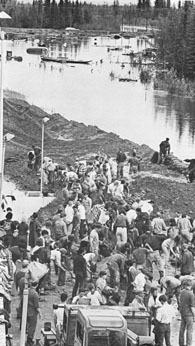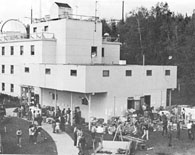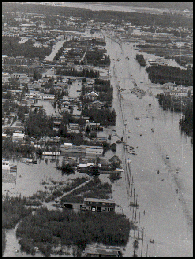Public Service: An Added Dimension, Fairbanks Flood 1967 - Part 3
This story about the university's important role in Fairbanks' 1967 flood appeared in July-August 1967 issue of Now in the North.

The story of the University of Alaska serving as a flood evacuation center could be
compared to a drama and like all dramas this one had several scenes.
And of these scenes, the most suspenseful by far, all hands seemed to agree was a
day-long struggle to keep the university's heating plant from being knocked out by
flood waters.
At stake in this battle were light, heat, and water for more than 7,000 flood victims
who had been evacuated to the campus.

The heating plant, built at a cost of $4 million, opened in January of 1964. It was
designed primarily to provide heat. Electric power is produced only as a by-product.
Under normal circumstances, the Golden Valley Electric Association supplies the bulk
of the university's power needs. This portion is the difference between the power
the heating plant generates as a by-product and the power needed on campus.
On August 15, the flooding Chena knocked out Genesee Valley and the university plant
was suddenly on its own. To produce all of the campus' power needs, plant engineers
stepped up production of heat, which in turn increased power production. The excess
was vented in the form of steam out an escape pipe at the side of the plant.
The same water that had kayoed Genesse Valley began to advance toward the heating
plant, situated on the lowest part of the campus, and engineers realized the plant
could be flooded.
At that point, the battle started. At first two bulldozers and a front-loader were
used to begin building a dike. When the water began to rise faster than the dike could
be built, a call for volunteers was issued. However two men—both evacuees—responded.
Engineers estimated that the water then was rising two inches an hour and at that
rate it would reach vital control equipment in six hours, forcing them to shut the
plant down.
A second call went out for volunteers and this time the call was aired not only over
the campus public address system but over the university's student station KUAC-FM,
and a Fairbanks radio station as well.

The response, recalls Gerald England, plant supervisor, was astounding. "I've never
seen anything like it. They started coming over that hill (a hill between the plant
and the upper part of the campus) like caribou—men, women and children."
The volunteers, most of them flood refugees, grabbed shovels and waded into waist-high
mud and sludge to fill sandbags for the dike. At the same time, a call went out for
pumps.
Water coming from a utilidor that extended from the flooded university warehouse to
the west to the plant basement was rising in the basement faster than the pumps on
hand could remove it.
Another major problem was a shortage of long hoses. The pumps removing water from
the basement were equipped with hoses only long enough to carry the water to an area
immediately adjacent to the building.

That area was inside the dike being constructed and at one point the water inside
the dike was higher than on the other side. A call was issued over the radio stations
for additional equipment.
